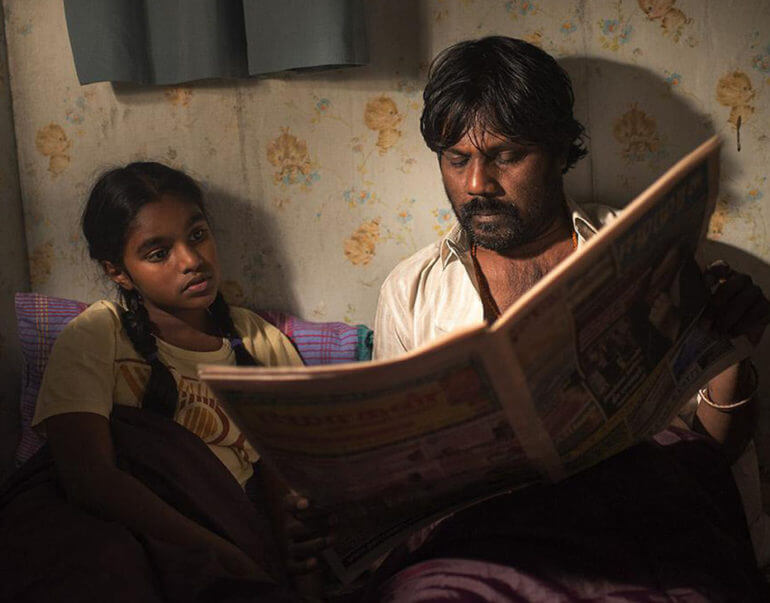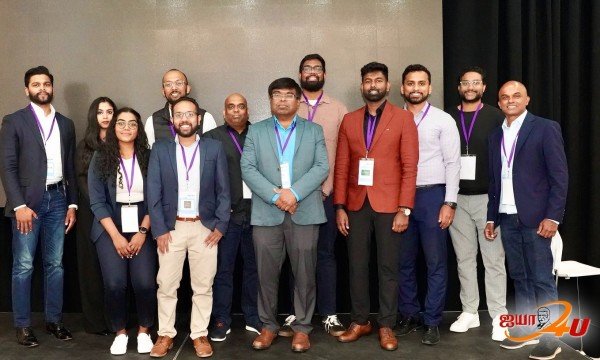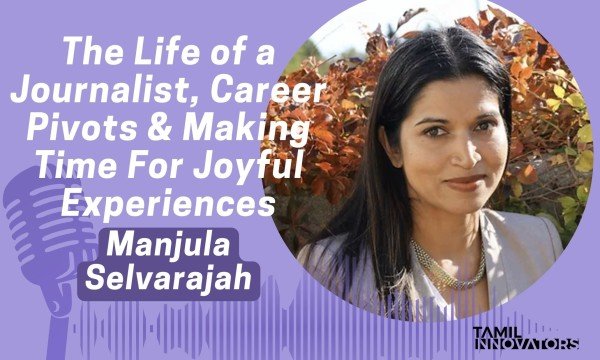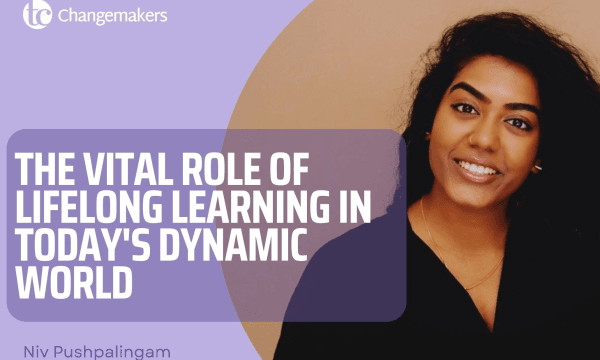
A horned-up general named Kicaka, or Keechaka, sees Draupadhi and “as soon as he saw her, in form like a divine maiden, a walking deity, the arrows of the god of love pierced him, and he desired her.
Scorched with the flames of desire, the general approached…and spoke these words: “I have never previously seen this lovely girl here in King Virata’s dwelling. She utterly intoxicates me with her beauty, as fresh as liquor intoxicates with its smell…I have a great house, richly endowed with many elephants, horse and chariots, opulent in its variety of food and drink, entrancing with its bright ornaments of gold—let her shed her radiance upon it!”
Kicaka’s behavior and love-at-first-sightedness is a frequent image present in Tamil cinema, the claim to the body of a woman, the objectification of her, the excessive force and devious behavior to seduce her, and the ways that patriarchy and masculinity perform itself on everything and everyone. She has the beauty; he has the property and valor. To say that nothing has changed since the times of the Mahabharata would be a grave exaggeration.
Draupadhi slyly rejects him: “Be not aroused, son of Suta; do not throw away your life today by desiring me, for I am unattainable, and heroes protect me. You cannot have me! My husbands are Gandharvas, and if you anger them they will slay you. So stop: do not destroy yourself. The road you wish to travel is impassable to men; you are trying to act like a wilful, foolish child who stands on the bank of a river and wants to cross to the other.”
Kicaka doesn’t take the hint and prepares a feast for Draupadhi and tells Queen Sudesna to send her to his house even though she vehemently refuses. At his house, Kicaka tries to stop Draupadhi from leaving his house so she throws “Kicaka to the floor and fled for protection to the hall where King Yudhisthira was. But as she fled, Kicaka laid hold of her by the hair, and before the king’s eyes threw her down and kicked her.” For the brothers who witness this act, acting upon it would be to reveal their disguise (dramatic tension!), so they watch in boiling anger as Draupadhi repeats, “I am the proud wife of men who could slay the whole world, but who are bound by the fetters of dharma—and the son of Suta has kicked me.”
When I’m in Paris, the Cannes International Film Festival is under way and the very good Blue is the Warmest Color is being touted as the likely Palme d’Or winner, which it later wins with actresses Adele Exarchopoulos and Lea Seydoux, unprecedentedly, awarded alongside the director for their integral part in the film just a few days after the 78 year-old Dominique Venner commits suicide by shooting himself in the head inside the Notre-Dame in protest against gay marriage laws in France.
Two years later, post-Charlie Hebdo and pre-Bataclan attacks, Audiard’s Dheepan premieres at Cannes to a lukewarm response and, surprisingly, wins the Palme d’Or for Audiard alone. Surprisingly only because Dheepan, which successfully tracks the highs and lows of the immigrant experience with cinematographic care rarely seen in Tamil cinema, falters into genre trappings and the rampant violence that are in excess in Tamil cinema, and it isn’t a very good or unique or ground-breaking or formally challenging film.
In 2015, Audiard is awarded for is cultural appropriation and he takes a photo on stage with Anthony and Kalieaswari on either side of him; it’s like an Olympic medaling, a pyramid, and the white man, the powerful, winner stands in the middle, so everyone can get a good look at the winner and the people that make it possible for that person be the winner—before they are sent off back into obscurity. You can barely see the features of the actor and actress in contrast to the pale, baldheaded Audiard. It reminds me of Claudia Rankine quoting Zora Neal Hurston in Citizen: An American Lyric: “I feel most colored when I am thrown against a sharp white background.”
On the train, I think of the separate trips my parents took towards the same place, they West-to-East and I East-to-West, on their way with fever dreams of their own kind, he on a train from Germany and she on a plane from Sri Lanka twenty years or so before. When I get to Paris I’m greeted by the overworked hands of my aunt, I almost pass out in a McDonald’s washroom across Gare du Nord, we almost get a parking ticket, and as the tiny green Peugeot halts at an intersection two immigrant children, boy and girl, with blue eyes, like the ones you see in a Steve McCurry exploitation, tap on the salt-specked window with their dirty palms asking for money.
I look at them feeling confronted, my fever and it’s dreams starting to break, and I looked around to see, as the children weaved through the traffic, everyone ignoring them until the traffic light changed and we drove away. It was at this moment, outside of the window, that my image of Paris was supplanted with the fact that like any other city, maudlin and romantic feelings aside, Paris was a place that people went to live and where their dreams went to die.
It’s incidences like this, like the interactions with the Romanian gypsies begging for money and other Others selling souvenirs, that sparked Jacques Audiard to create Dheepan. In an interview with The Film Stage, he says, “It’s probably the guy who sells roses at cafés. When you send them off, you don’t look at them, but they do have their own stories. That’s what we’re telling here.”
Audiard’s failure to look, to actually see these people and engage. His ignorance to see that Tamils have been telling their own stories for decades through their own thriving cinema industry is appalling, and it is apparent that the Tamil people, the war, the actors just become a way that, as bell hooks says, “becomes spice, seasoning that can liven up the dull dish that is mainstream white culture,” and Audiard’s own dying mould.
Draupadhi later tells Kicaka to meet at the dance hall. Unbeknownst to him, Bhima, the husband who is most angry, waits there and kills him. Kicaka’s men discover the body, get angry, blame Draupadhi and try to burn her at the stake. But Bhima kills all of them, about hundred, like any hero at once and alone. At the end of this section, Queen Sudesna tells Draupadhi to leave the palace, but she asks to stay thirteen more days for it will all be over soon. King Virata gives “orders for the last rites to be performed for the Sutas: ‘Let all the Kicaka’s folk be quickly cremated on a single well-blazing pyre, with plenty of gems and incense!’”
As that section of the Mahabharata ends with a well-blazing pyre and R. Nataraja Mudaliar’s career and films end up in a fire, the Jaffna Library rebuilds itself from the fire in the same way that Jacques Audiard begins to build Dheepan with a well-blazing pyre of its own—full of Tamil bodies in bloody clothes that later become just skulls and memories.
From the get-go, Dheepan poses a problem: as the camera pans across the Sri Lankan landscape, it is slowly revealed by the names of the production companies that made the film through which you can see glimmers of palm tree leaves and sand. These are the first words/images seen on screen: PAGE 114 ET WHY NOT PRODUCTIONS PRESENTENT UNE COPRODUCTION WHY NOT PRODUCTIONS PAGE 114 FRANCE 2 CINEMA AVEC LA PARTICIPATION DE CANAL + CINE + FRANCE TELEVISIONS AVEC LE SOUTIEN DE LA REGION ILE-DE-FRANCE EN ASSOCIATION AVEC CINEIMAGE 9 A PLUS IMAGE 5 PALATINE ETOILE 12 INDEFILMS 3 LA BANQUE POSTALE IMAGE 8 COFINOVA 11 SOFITVCINE 2 SOFICINEMA 11.
They are all French production companies. Only through these words and names which represent French money and interest can you see the Sri Lankan landscape. The proceeding images will be filtered and mediated through these companies, the first image seems to read, and only through their gaze will you be able to see the story of Sri Lankans. The film is told by the lens and hands of a French man and the way he sees Sri Lankans and their immigration experience—the images are tainted, washed in white, colonized. On top of the Sri Lankan landscape is a stamp of French approval.
When asked in the interview with Jonathan Romney for The Guardian on why Audiard wanted to make a film about Tamils, this answer, obviously, ensues: “He didn’t, he says. When he first started planning Dheepan, immediately after finishing A Prophet, he knew nothing about Tamils. The idea was to attempt a remake of Sam Peckinpah’s Straw Dogs. ‘I had this idea of immigrants arriving on an estate, being taken hostage and so on. Then I watched the Peckinpah again, and…well, I couldn’t quite see why I’d had the idea in the first place. But I had this idea of people coming to France who had no connection with the old colonial empire, so had no reference points in terms of language and culture.”
bell hooks further examines the type of cultural appropriation Audiard expresses: “Cultural appropriation of the Other assuages feelings of deprivation and lack that assault the psyches of radical white youth who choose to be disloyal to Western civilization. Concurrently, marginalized groups, deemed Other, who have been ignored, rendered invisible, can be seduced by the emphasis on Otherness, by its commodification, because it offers the promise of recognition and reconciliation.” This type of appropriation should be defined as the Slumdog-Syndrome.
To Be Continued...

























